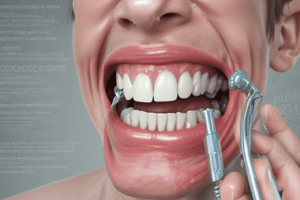Podcast
Questions and Answers
A patient reports a sharp, fleeting pain in a tooth when exposed to cold, which quickly subsides upon removal of the stimulus. Which pulpal diagnosis is most likely?
A patient reports a sharp, fleeting pain in a tooth when exposed to cold, which quickly subsides upon removal of the stimulus. Which pulpal diagnosis is most likely?
- Asymptomatic irreversible pulpitis
- Symptomatic irreversible pulpitis
- Pulp necrosis
- Reversible pulpitis (correct)
In which of the following pulpal diagnoses is the pulp considered vital but incapable of healing?
In which of the following pulpal diagnoses is the pulp considered vital but incapable of healing?
- Symptomatic irreversible pulpitis (correct)
- Normal pulp
- Pulp necrosis
- Reversible pulpitis
What is the typical clinical characteristic of a tooth diagnosed with pulp necrosis?
What is the typical clinical characteristic of a tooth diagnosed with pulp necrosis?
- Sharp pain upon percussion
- Nonresponsive to pulp testing (correct)
- Response to thermal testing
- Spontaneous, lingering pain
Which of the following best describes the etiology of reversible pulpitis?
Which of the following best describes the etiology of reversible pulpitis?
A patient presents with a history of trauma to a tooth. The tooth is asymptomatic but responds normally to thermal testing. Radiographic examination reveals deep caries. Which pulpal diagnosis is most likely?
A patient presents with a history of trauma to a tooth. The tooth is asymptomatic but responds normally to thermal testing. Radiographic examination reveals deep caries. Which pulpal diagnosis is most likely?
What is a key characteristic differentiating symptomatic irreversible pulpitis from reversible pulpitis?
What is a key characteristic differentiating symptomatic irreversible pulpitis from reversible pulpitis?
A patient's tooth has undergone partial endodontic therapy, such as a pulpotomy. Which pulpal diagnosis category applies to this tooth?
A patient's tooth has undergone partial endodontic therapy, such as a pulpotomy. Which pulpal diagnosis category applies to this tooth?
Which clinical scenario best describes a tooth that would be diagnosed as 'Previously Treated'?
Which clinical scenario best describes a tooth that would be diagnosed as 'Previously Treated'?
If a tooth is nonresponsive to pulp testing, but the patient reports no symptoms, which pulpal condition should be considered?
If a tooth is nonresponsive to pulp testing, but the patient reports no symptoms, which pulpal condition should be considered?
The lamina dura appears intact on a radiograph, and the tooth is not sensitive to percussion or palpation. Which periapical diagnosis is most consistent with these findings?
The lamina dura appears intact on a radiograph, and the tooth is not sensitive to percussion or palpation. Which periapical diagnosis is most consistent with these findings?
What is the primary difference between symptomatic and asymptomatic apical periodontitis?
What is the primary difference between symptomatic and asymptomatic apical periodontitis?
Which periapical diagnosis is characterized by rapid onset, spontaneous pain, extreme tenderness to the tooth to pressure, and potential swelling?
Which periapical diagnosis is characterized by rapid onset, spontaneous pain, extreme tenderness to the tooth to pressure, and potential swelling?
A patient presents with a draining sinus tract associated with a tooth. Which periapical diagnosis is most likely?
A patient presents with a draining sinus tract associated with a tooth. Which periapical diagnosis is most likely?
What is the recommended procedure for identifying the source of a draining sinus tract?
What is the recommended procedure for identifying the source of a draining sinus tract?
Which of the following best describes condensing osteitis in the context of periapical diagnoses?
Which of the following best describes condensing osteitis in the context of periapical diagnoses?
A patient reports a gradual onset of discomfort and intermittent pus discharge from a tooth. What condition is likely?
A patient reports a gradual onset of discomfort and intermittent pus discharge from a tooth. What condition is likely?
Why should comparative testing for percussion and palpation begin with normal teeth?
Why should comparative testing for percussion and palpation begin with normal teeth?
How does the definition of a sinus tract differ from that of a fistula in endodontic terms?
How does the definition of a sinus tract differ from that of a fistula in endodontic terms?
When might a tooth be nonresponsive to pulp testing, even if it's not necrotic?
When might a tooth be nonresponsive to pulp testing, even if it's not necrotic?
During a clinical exam, a patient reports a painful response to biting or percussion on a particular tooth. Which condition may the patient be experiencing?
During a clinical exam, a patient reports a painful response to biting or percussion on a particular tooth. Which condition may the patient be experiencing?
A patient's radiograph shows an apical radiolucency, but they report no pain. What condition is likely?
A patient's radiograph shows an apical radiolucency, but they report no pain. What condition is likely?
Which condition involves the rapid onset of pain and swelling?
Which condition involves the rapid onset of pain and swelling?
What is the clinical significance of identifying a sinus tract?
What is the clinical significance of identifying a sinus tract?
What diagnostic method is used for condensing osteitis?
What diagnostic method is used for condensing osteitis?
What pulpal and periapical diagnosis might you suspect in a patient presenting with a tooth that hurts dramatically upon chewing, with no sinus tract, but a radiograph that shows periapical inflammation?
What pulpal and periapical diagnosis might you suspect in a patient presenting with a tooth that hurts dramatically upon chewing, with no sinus tract, but a radiograph that shows periapical inflammation?
Flashcards
Normal Pulp
Normal Pulp
A clinical diagnostic category where the pulp is symptom-free and responds normally to pulp testing.
Reversible Pulpitis
Reversible Pulpitis
A clinical diagnosis indicating inflammation of the pulp that should resolve, allowing it to return to normal. Mild symptoms like thermal sensitivity may be present.
Asymptomatic Irreversible Pulpitis
Asymptomatic Irreversible Pulpitis
A clinical diagnosis indicating pulp inflammation that cannot heal. Typically, there's a history of trauma/ deep caries that will likely result in exposure following removal. It usually responds normally to thermal testing.
Symptomatic Irreversible Pulpitis
Symptomatic Irreversible Pulpitis
Signup and view all the flashcards
Pulp Necrosis
Pulp Necrosis
Signup and view all the flashcards
Previously Initiated Therapy
Previously Initiated Therapy
Signup and view all the flashcards
Previously Treated
Previously Treated
Signup and view all the flashcards
Normal Apical Tissues
Normal Apical Tissues
Signup and view all the flashcards
Symptomatic Apical Periodontitis
Symptomatic Apical Periodontitis
Signup and view all the flashcards
Asymptomatic Apical Periodontitis
Asymptomatic Apical Periodontitis
Signup and view all the flashcards
Acute Apical Abscess
Acute Apical Abscess
Signup and view all the flashcards
Chronic Apical Abscess
Chronic Apical Abscess
Signup and view all the flashcards
Fistula
Fistula
Signup and view all the flashcards
Sinus Tract
Sinus Tract
Signup and view all the flashcards
Condensing Osteitis
Condensing Osteitis
Signup and view all the flashcards
Study Notes
Pulpal Diagnosis Categories
- Normal Pulp
- Reversible Pulpitis
- Asymptomatic Irreversible Pulpitis
- Symptomatic Irreversible Pulpitis
- Pulp Necrosis
- Previously Initiated
- Previously Treated
Pulpal Inflammation
- Inflammation begins and progresses, either reversibly or irreversibly.
Pulpal Degeneration
- Progresses from normal pulp, to reversible pulpitis, which can become either symptomatic or asymptomatic irreversible pulpitis, and can eventually result to pulp necrosis
Normal Pulp
- Defines a clinical diagnostic category where the pulp is symptom-free and responds normally to pulp testing.
Reversible Pulpitis
- Clinical diagnosis based on subjective and objective findings, inflammation should resolve, and the pulp should return to normal.
- Mild symptoms, such as thermal stimulus, may be reported.
- Etiology can be caused by caries, exposed dentin, recent dental treatment, or defective restorations.
Asymptomatic Irreversible Pulpitis
- Clinical diagnosis where the vital inflamed pulp is incapable of healing.
- Patients typically have a history of trauma or deep caries, likely resulting in exposure after removal.
- Usually responds normally to thermal testing.
- Usually has a history of trauma or deep caries that likely results in exposure following removal.
Symptomatic Irreversible Pulpitis
- Clinical diagnosis involving a vital inflamed pulp incapable of healing.
- Characteristics include sharp, lingering thermal pain (>30 seconds after removal), spontaneous pain, referred pain, and pain waking the patient from sleep.
- Over-the-counter analgesics are typically ineffective.
Pulp Necrosis
- Clinical diagnostic category indicating the death of the dental pulp.
- The pulp is usually nonresponsive to pulp testing and asymptomatic.
- Teeth may be nonresponsive to pulp testing due to calcification, recent trauma history, or if the tooth simply is not responding, but this does not necessarily indicate necrosis.
Previously Initiated Therapy
- Clinical diagnostic category indicating that the tooth has been previously treated by partial endodontic therapy, like pulpotomy or pulpectomy.
Previously Treated
- Clinical diagnostic category indicating that the tooth has been endodontically treated.
- The canals are obturated with various filling materials other than intracanal medicaments.
Periapical Diagnosis
- Pulp necrosis and bacteria must be present to cause periapical degeneration.
Periapical Diagnosis Categories
- Normal Apical Tissues
- Symptomatic Apical Periodontitis
- Asymptomatic Apical Periodontitis
- Acute Apical Abscess
- Chronic Apical Abscess
- Condensing Osteitis
Normal Apical Tissues
- Clinical tests show normal response, without sensitivity to percussion or palpation.
- Radiographs should show an intact lamina dura surrounding the root and a uniform periodontal ligament space.
- Comparative testing for percussion and palpation should begin with normal teeth as a baseline.
Symptomatic Apical Periodontitis
- Definition: Inflammation typically affects the apical periodontium, resulting in clinical symptoms.
- Clinical exam: There is usually a painful response to biting and/or percussion or palpation.
- Changes can be present depending on the progression of the disease.
Asymptomatic Apical Periodontitis
- Characterized by inflammation and destruction of the apical periodontium of pulpal origin.
- Clinical exam: There is a normal response, with no symptoms to percussion/palpation.
- Radiographic exam: Presents as an apical radiolucency.
- Differentiating from anatomic features or non-endodontic pathology needs to be done with pulpal testing.
Acute Apical Abscess
- Inflammatory reaction to pulpal infection and necrosis, characterized by rapid onset, spontaneous pain, extreme tenderness to pressure, pus formation, and swelling of tissues.
- Patients may experience malaise, fever, and lymphadenopathy.
- Radiographic changes may or may not be noted.
Chronic Apical Abscess
- An inflammatory reaction to pulpal infection and necrosis is characterized by gradual onset, little to no discomfort, and intermittent pus discharge through a sinus tract.
- Radiographic exam generally shows osseous destruction, such as radiolucency.
- Source of a draining sinus tract is identified by putting a gutta percha cone through the stoma until it stops and taking a radiograph.
Sinus Tract vs. Fistula
- Fistula: abnormal communication pathway between 2 internal organs.
- Sinus Tract: pathway from an enclosed infected area to an epithelial surface.
- Sinus tract opening or stoma is typically intraoral or extraoral and allows pus discharge, and typically disappears when causative factor by endodontic treatment.
Condensing Osteitis
- Diffuse radiopaque lesion shown as a localized bony reaction to low-grade inflammatory stimulus, usually seen at the apex of the tooth.
- Radiographic diagnosis that can be specified as an adjunct to another periapical diagnoses, such as symptomatic apical periodontitis with condensing osteitis.
Studying That Suits You
Use AI to generate personalized quizzes and flashcards to suit your learning preferences.





